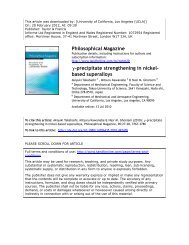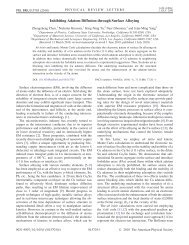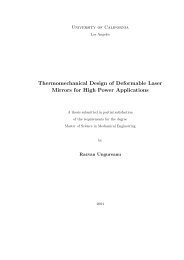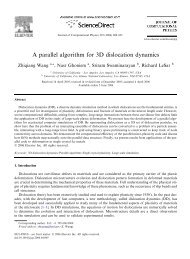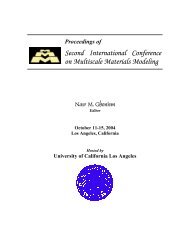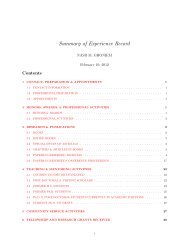FS&T Template - Nasr Ghoniem's Matrix Laboratory - UCLA
FS&T Template - Nasr Ghoniem's Matrix Laboratory - UCLA
FS&T Template - Nasr Ghoniem's Matrix Laboratory - UCLA
Create successful ePaper yourself
Turn your PDF publications into a flip-book with our unique Google optimized e-Paper software.
Sharafat et al.<br />
for 65 and 100 pores per linear inch (ppi) foam at 10%<br />
and 20% density. The average thermal conductivity of<br />
10% dense, 100 ppi SiC foam is close to 1.0 W/m-K at<br />
700 o C, which is less than the required 2 W/m-K for the<br />
FCI structure. The effective electrical conductivity of FCI<br />
development structure with 8 mm thick, 20% dense, 65<br />
ppi foam and 0.08 mm thick face sheets was measured<br />
and found to be less than 0.2 S/m at a current of 1 A (Ref.<br />
11). Prior to testing, the residual carbon at the core of the<br />
SiC foam ligaments was removed by oxidation. The low<br />
electrical conductivity of the FCI development piece<br />
indicates that design requirements of less than ~1 S/m are<br />
readily met using SiC foam sandwiched between two<br />
CVD SiC face sheets.<br />
SiC-FOAM BASED FLOW CHANNEL INSERT FOR DCLL TBM<br />
CVD SiC face sheets. For finite element analysis a three<br />
layered material model was used to represent the CVD-<br />
Foam-CVD structure of the FCI wall. Here, we assume<br />
that each layer consists of a homogeneous material. For<br />
the 1-mm thick face sheets, CVD-SiC material properties<br />
-<br />
measured SiC-foam properties were assigned. (Table II).<br />
This analysis is, thus by its nature not exact in that the<br />
local response of individual SiC-foam ligaments are not<br />
analyzed. Therefore, the uncertainty associated with this<br />
FEM analysis must be taken into account in ascertaining<br />
the performance of this structure.<br />
Fig. 5: (a) Cross-sectional photograph of 10-mm thick<br />
12% dense CVD SiC foam with 1.8 mm thick CVD SiC<br />
face sheets; (b) 5-mm thick 22% dense CVD SiC foam<br />
with 1.8 mm thick CVD SiC face sheets; (both 5X); (c)<br />
FCI development specimen in 4-point bend fixture; (d)<br />
post-test photo of torch-tested SiC faceplate surface<br />
(1200 o C) (2X). 11<br />
Limited room temperature mechanical property<br />
measurements of SiC foam have been made. Figure 7<br />
shows the strength and modulus of SiC foam as functions<br />
of bulk density. 11 Under compression, 10% dense SiC<br />
foam (0.32 g/cc) had a modulus of about 6 GPa, which<br />
rises to about 15 GPa at a 20% density. In tension, the<br />
modulus of 10% and 20% dense SiC foams are about 3<br />
GPa and 8 GPa, respectively. Tensile/compressive<br />
strengths of 10% and 20% SiC foams are about 3.5/10.5<br />
MPa and 7.6/27.2 MPa, respectively.<br />
IV. THERMO-MECHANICAL ANALYSIS<br />
The FCI model used for thermo-mechanical analysis<br />
is shown in Fig. 3, which shows a cross sectional view of<br />
one of five FCI segment. The FCI panel consists of a 3-<br />
mm thick foam sandwiched between two 1-mm thick<br />
Fig. 6: Thermal conductivity versus temperature of 65 and<br />
100 ppi SiC foam at 10% and 20% dense and electrical<br />
conductivity for 20% dense SiC foam with 1.8-mm CVD<br />
face-sheets (w/o carbon core). 11<br />
Two thermo-mechanical analyses were conducted,<br />
one on a single segment with a constant heat flux from the<br />
inside of the FCI and the other on the entire structure<br />
using detailed temperature maps, generated in conjunction<br />
with magnetohydrodynamic models. 5 The thermal loading<br />
conditions for the single FCI segment were chosen such<br />
that a mean temperature difference of about 40 o C (Ref. 1)<br />
would exist between the inside and the outside of the FCI.<br />
A heat flux of 0.2 MW/m 2 was applied to all inner areas<br />
of the FCI and the outside surfaces were cooled assuming<br />
a PbLi temperature of 450 o C with a heat transfer<br />
coefficient of 10 000 W/m 2 -K. The brackets are not<br />
bonded to the FCI SiC-foam panels, rather they are<br />
simply slid into each other. Hence, there is a thermal<br />
resistance across the contact area between the bracket and<br />
the face sheet. The heat transfer coefficient of ceramic-toceramic<br />
joints ranges between 500 W/m 2 -K to 3000<br />
FUSION SCIENCE AND TECHNOLOGY VOL. 56 AUG. 2009 887



